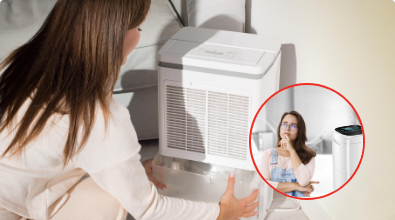Introduction
Maintaining the optimal humidity level inside living spaces is very important for our comfort and good health. High humidity levels can cause several issues, including mold growth, musty odors, and damage to furniture and electronics.
With the help of a dehumidifier, we can keep humidity inside homes within permissible limits. However, selecting the correct dehumidifier capacity is essential for it to work effectively and efficiently.
The Association of Home Appliance Manufacturers (AHAM) method makes capacity selection easy for homeowners with its dehumidifier size calculator table. It is a reliable and effective way to determine the appropriate capacity to ensure the device's optimal performance and energy efficiency.
This method assists the protective buyer in how to do the right dehumidifier calculation. It gives a step-by-step procedure to choose the correct model according to your room size and current humidity level inside your home.
Why is it crucial to select the right capacity dehumidifier for homes?
Selecting a suitable capacity dehumidifier for homes is crucial for several reasons. As we are all aware, neglecting the issue of high humidity levels can cause several problems, such as mold growth, musty odors, and damage to furniture and electronics.
If we buy an under-capacity dehumidification system, then it may not remove the moisture altogether from the air. As a result, we need to keep struggling with high humidity issues.
Humidity dryers consist of compressors and coils, which consume a lot of energy. Selecting a unit of more rating than required can increase your utility bills. On the other hand, if we choose over capacity dehumidifiers, we will spend more on the purchase and running cost.
Therefore, selecting the right capacity dehumidifier for your home is crucial to ensure optimal performance and avoid any potential problems.
Step 1: Determine the Area and Volume of the Space for dehumidifier sizing.
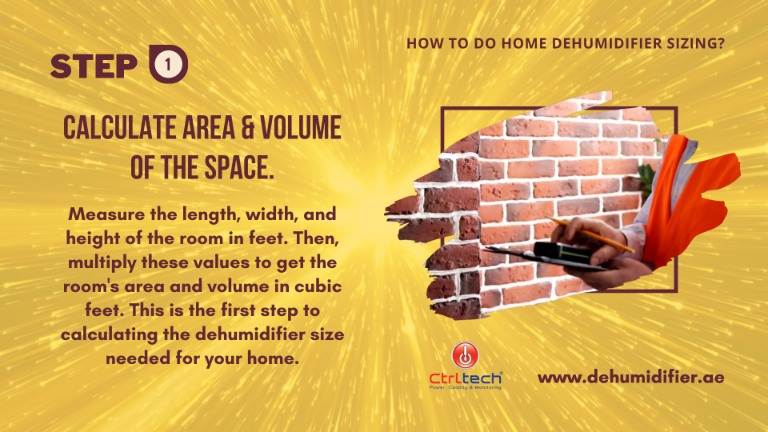
The first step toward dehumidifier sizing is to visit the site to get the dimensions of the space that you like to dehumidifier. Note down the room's length, Width, and Height in feet. Measure these dimensions in meters and calculate the area of the space in square feet...
We need the volume of the space, which we can get with the help of the area and Height of the room. This information will help you estimate the moisture removal capacity required.
The relation between the volume of the room and the dehumidifier capacity is directly proportional. The larger space is occupied by more air, and hence it needs a high-capacity dehumidifier to dry this air.
However, other factors like current and required humidity level and ventilation will affect the dehumidifier calculation. Read more
Step 2: Identify room humidity with the help of AHAM dehumidifier size chart.
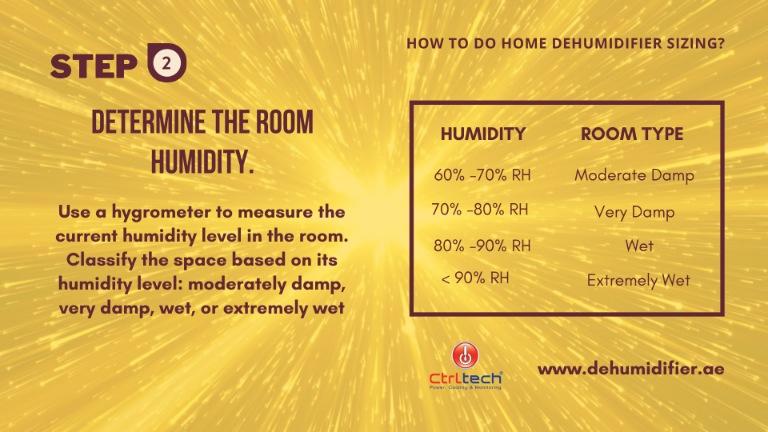
Next, evaluate the moisture level in the area. Get one hygrometer to measure the current humidity level in the room. The AHAM classifies moisture levels into four categories:
Moderately damp: Space feels damp and musty with a humidity level of 60% to 70% RH, especially during humid climate...
Very damp: This type of space always feels damp and has a musty odor. Damp spots may be visible on walls and floors. These living rooms have a moisture level of 70 to 80% RH.
Wet: Space feels and smells wet due to room humidity of 80 to 90%. Walls or floors may show signs of moisture seepage.
Extremely wet: Space has potential standing water or flooding issues. In such cases, humidity levels are often more than 90% RH.
Based on humidity reading, users can decide which category their spaces should be classified.
Read more
Step 3: Determine the Required Dehumidifier Capacity with the AHAM dehumidifier size calculator table.
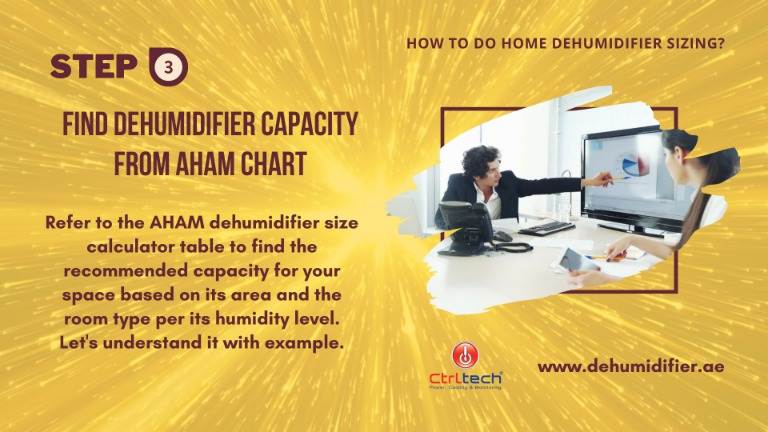
Once you decide if your room is moderately damp, very damp, Wet, or extremely wet, it is time to select the unit's capacity using the AHAM dehumidification chart. For this chart, for your room area in square feet and humidity level in your room, you can get the liters per day capacity of the unit...
For example, the area of your room is 1000 square feet, and the humidity in the room is 75% which means it is very damp. Then, as per the AHAM dehumidifier room size chart required capacity is 9.7 liters per day. Read more
Step 4: Adjust the capacity for Special Circumstances.
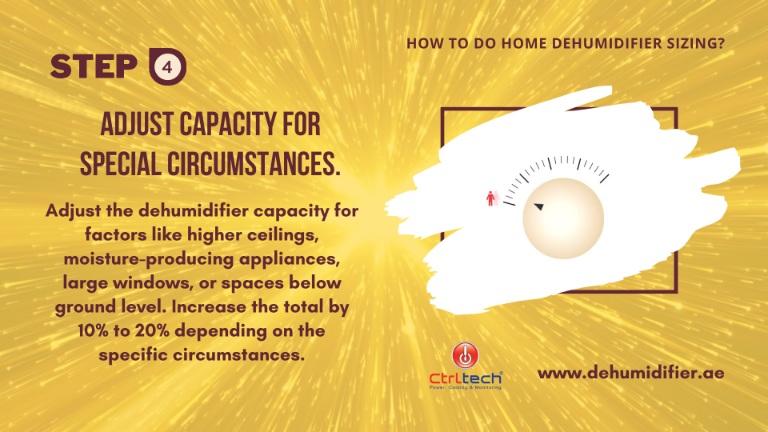
Many factors can affect the dehumidifier sizing, and we cannot factor in the calculation based on the AHAM dehumidifier size chart. For example, the room height, number of people in the room, and window and door size, which cause ventilation, can increase the required rating of the dehumidification system.
If the space has any of the following conditions, adjust the dehumidifier capacity accordingly:
Step 5: Determine the CFM Airflow Volume Needed.

In step 2, we calculated the room volume in cubic feet. Using this, we can determine the CFM airflow needed for that room. A cubic meter per minute, or CFM, is a unit to measure the airflow. Selecting a unit with sufficient airflow is very crucial for the correct dehumidifier sizing.
To determine the required CFM airflow volume, you need to consider two factors: the area of the room and the humidity level. The area of the room determines how much air should pass through the dehumidifier.
And the space's humidity level determines how often this air should pass through the unit in an hour. This term is denoted as ACH or air changes per hour.
ACH is a crucial factor in dehumidifier size calculation. To calculate air flow in CFM, we need to multiply the volume of the room by the recommended ACH for that room. To get the room's volume, multiply the room's area by its Height.
After that, divide the multiplication by 60 to get CFM. Please note that the area should be in square feet. The recommended ACHs for different rooms are as follows.
Moderately damp: Recommended ACH is 3. ..
Very damp: Recommended ACH is 4.
Wet: Recommended ACH is 5.
Extremely wet: Recommended ACH is 6.
For example, let's take a case for dehumidifier capacity sizing. If you have a room that is 200 square feet and 8 feet high, and the recommended ACH is 6 for moderately damp conditions, the calculation would be:
Volume of the room = 200 sq. ft. x 8 ft. = 1600 cubic feet
CFM airflow volume needed = (1600 cubic feet x 6 ACH) / 60 = 160 CFM
Determining the CFM airflow volume needed for the room ensures that the dehumidifier is appropriately sized for the space and can effectively remove excess moisture from the air.
It can help maintain optimal humidity levels and prevent mold growth, musty odors, and damage to furniture and electronics.
Read more
Step 6: Select the Dehumidifier features.

Now that you have determined the required dehumidifier capacity for your space, look for a unit that matches or slightly exceeds this capacity. Selecting a dehumidification system with the right features and the correct dehumidifier sizing is equally important...
For example, features like Energy efficiency, noise levels, built-in pumps, digital controls, and auto shut-off should also be considered when making your final selection. Read more
Step 7: Monitor humidity level and adjust.

After installing your dehumidifier, continuously monitor the humidity levels in your space using a hygrometer. You can use an external hygrometer or the digital display of the dehumidifier. The humidity should be maintained between 45% and 55% for the living spaces...
If you notice that the humidity levels are not adequately controlled, first adjust the settings on your dehumidifier. If the situation does not improve, consider upgrading to a larger capacity unit.
In summary, selecting a suitable capacity dehumidifier is crucial for maintaining a comfortable and healthy indoor environment.
By following the AHAM dehumidifier sizing method, you can effectively determine the appropriate dehumidifier size for your home, ensuring optimal performance and energy efficiency. Read more










